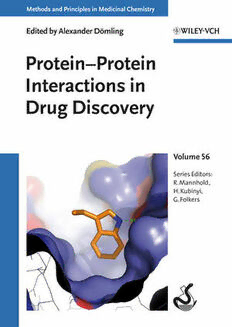
Protein-Protein Interactions in Drug Discovery PDF
Preview Protein-Protein Interactions in Drug Discovery
Editedby AlexanderD€omling Protein–ProteinInteractions inDrugDiscovery RelatedTitles MethodsandPrinciplesinMedicinalChemistry EditedbyR.Mannhold,H.Kubinyi,G.Folkers EditorialBoard H.Buschmann,H.Timmerman,H.vandeWaterbeemd,T.Wieland PreviousVolumesofthisSeries Kalgutkar,AmitS./Dalvie,Deepak/ DeClercq,Erik(Ed.) Obach,R.Scott/Smith,DennisA. AntiviralDrugStrategies ReactiveDrugMetabolites 2011 2012 ISBN:978-3-527-32696-9,Vol.50 ISBN:978-3-527-33085-0,Vol.55 Klebl,Bert/Mu€ller,Gerhard/Hamacher, Brown,Nathan(Ed.) Michael(Eds.) BioisosteresinMedicinal ProteinKinasesasDrug Chemistry Targets 2012 2011 ISBN:978-3-527-33015-7,Vol.54 ISBN:978-3-527-31790-5,Vol.49 Gohlke,Holger(Ed.) Sotriffer,Christoph(Ed.) Protein-LigandInteractions VirtualScreening Principles,Challenges,andPractical 2012 ISBN:978-3-527-32966-3,Vol.53 Guidelines 2011 Kappe,C.Oliver/Stadler,Alexander/ ISBN:978-3-527-32636-5,Vol.48 Dallinger,Doris Rautio,Jarkko(Ed.) MicrowavesinOrganicand ProdrugsandTargeted MedicinalChemistry DeliveryTowardsBetterADME Second,CompletelyRevisedand Properties EnlargedEdition 2011 2012 ISBN:978-3-527-32603-7,Vol.47 ISBN:978-3-527-33185-7,Vol.52 Smit,MartineJ./Lira,SergioA./Leurs, Smith,DennisA./Allerton,Charlotte/ Rob(Eds.) Kalgutkar,AmitS./vandeWaterbeemd, Han/Walker,DonK. ChemokineReceptorsasDrug Pharmacokineticsand Targets MetabolisminDrugDesign 2011 Third,RevisedandUpdatedEdition ISBN:978-3-527-32118-6,Vol.46 2012 ISBN:978-3-527-32954-0,Vol.51 € Edited by Alexander Domling – Protein Protein Interactions in Drug Discovery SeriesEditors AllbookspublishedbyWiley-VCHarecarefully produced.Nevertheless,authors,editors,and Prof.Dr.RaimundMannhold publisherdonotwarranttheinformationcontained MolecularDrugResearchGroup inthesebooks,includingthisbook,tobefreeof Heinrich-Heine-Universit€at errors.Readersareadvisedtokeepinmindthat Universit€atsstrasse1 statements,data,illustrations,proceduraldetailsor 40225Du€sseldorf otheritemsmayinadvertentlybeinaccurate. Germany LibraryofCongressCardNo.:appliedfor [email protected] BritishLibraryCataloguing-in-PublicationData Prof.Dr.HugoKubinyi Acataloguerecordforthisbookisavailablefromthe Donnersbergstrasse9 BritishLibrary. 67256WeisenheimamSand BibliographicinformationpublishedbytheDeutsche Germany Nationalbibliothek [email protected] TheDeutscheNationalbibliothekliststhis publicationintheDeutscheNationalbibliografie; Prof.Dr.GerdFolkers detailedbibliographicdataareavailableonthe CollegiumHelveticum Internet at < http:// dnb.d-nb.d e> . STW/ETHZurich 8092Zurich #2013Wiley-VCHVerlagGmbH&Co.KGaA, Switzerland Boschstr.12,69469Weinheim,Germany [email protected] Allrightsreserved(includingthoseoftranslationinto otherlanguages).Nopartofthisbookmaybe VolumeEditor reproducedinanyform–byphotoprinting, Prof.Dr.AlexanderD€omling microfilm,oranyothermeans–nortransmittedor translatedintoamachinelanguagewithoutwritten UniversityofGroningen permissionfromthepublishers.Registerednames, SchoolofPharmacy trademarks,etc.usedinthisbook,evenwhennot DrugDesign specificallymarkedassuch,arenottobeconsidered AntoniusDeusinglaan1 unprotectedbylaw. 9713AVGroningen Netherlands Composition ThomsonDigital,Noida,India PrintingandBinding MarkonoPrintMediaPteLtd, Cover Singapore Cut-awayviewoftheco-crystalstructureofan archetypicalprotein-proteininteraction:the CoverDesign SchulzGrafik-Design,Fu(cid:2)g€onheim tumorsuppressorp53andtheoncogene PrintISBN: 978-3-527-33107-9 MDM2(PDBID1YCR).Themostdeepest ePDFISBN: 978-3-527-64823-8 buriedp53aminoacidTrp23,anchoringthe ePubISBN: 978-3-527-64822-1 PPI,isshowninstickspresentation,theMDM2 mobiISBN: 978-3-527-64821-4 receptorisshownassurface.Alsoshownthe oBookISBN: 978-3-527-64820-7 hydrogenbondbetweentheTrp23indole-NH andthereceptorLeu54carbonylasgreen PrintedinSingapore dottedline.Thepicturewasrenderedusing Printedonacid-freepaper PYMOLsoftware. j V Contents ListofContributors XI Preface XV APersonalForeword XVII 1 Protein–ProteinInteractions:AnOverview 1 ChristianOttman 1.1 Introduction 1 1.2 RoleofPPIsinHumanPhysiology 2 1.3 RegulationofPPIs 3 1.4 StructuralFeaturesofPPIInterfaces 3 1.4.1 iNOSHomodimer 5 1.4.2 b-Catenin/Tcf4Complex 5 1.4.3 LEDGF/HIV-INComplex 6 1.4.4 HPVE1/E2Complex 7 1.4.5 IFN-a/IFNARComplex 8 1.4.6 TNF-aTrimer 9 1.5 IdentificationofPPIInhibitors 10 1.6 ConclusionsandOutlook 13 References 14 2 PredictionofIntra-andInterspeciesProtein–ProteinInteractions FacilitatingSystemsBiologyStudies 21 SylviaSchleker,SeshanAnanthasubramanian,JudithKlein-Seetharaman, andMadhaviK.Ganapathiraju 2.1 Introduction:RelevanceofInteractomeStudiestoDiseaseandDrug Discovery 21 2.2 OurCurrentKnowledgeofInteractomesIdentifiedfrom ExperimentsisIncomplete 23 2.3 ReliabilityofInteractionsIdentifiedExperimentally 24 2.4 ComputationalMethodsforPPIPrediction 27 2.4.1 ConservationofGeneNeighborhood 27 2.4.2 GeneFusion 28 2.4.3 Sequence-BasedCoevolution 28 j VI Contents 2.4.4 PhylogeneticProfiling 28 2.4.5 GeneExpression 29 2.4.6 StructuralSimilarity 29 2.4.7 IntegrationApproaches 29 2.5 SourcesofBiologicalDatainUsetoPredictPPIs 30 2.6 SurveyofCurrentInteractomes 32 2.6.1 HumanIntraspeciesInteractomes 32 2.6.2 BacteriaIntraspeciesInteractomes 37 2.6.2.1 High-ThroughputExperimentalApproachestoIdentifyIntraspecies BacterialInteractions 37 2.6.2.2 ModelingIntraspeciesBacterialInteractions 39 2.6.3 Bacteria–HumanInterspeciesInteractomes 40 2.6.3.1 ExperimentalApproachestoIdentifyBacteria–HumanPPIs 40 2.6.3.2 ModelingBacteria–HumanPPIs 40 2.6.4 Non-PPIIntraspeciesBacterialandBacteria–HumanInterspecies InteractomeModels 41 2.6.5 Virus–HumanInterspeciesInteractomes 42 References 43 3 ModulatorsofProtein–ProteinInteractions:Importance ofThree-Dimensionality 55 DavidC.FryandSung-SauSo 3.1 Introduction 55 3.2 Study 56 3.3 Discussion 58 3.4 Summary 61 References 61 4 ALeapintotheChemicalSpaceofProtein–ProteinInteraction Inhibitors 63 BrunoO.Villoutreix,C.Labb(cid:1)e,DavidLagorce,GuillaumeLaconde, andOlivierSperandio 4.1 Introduction 63 4.2 TypesofInteraction 64 4.3 PropertiesoftheInterface 65 4.4 OrthostericversusAllostericModulation 66 4.5 LeapintotheiPPIChemicalSpace 66 4.5.1 SeminalWorks 66 4.5.2 RoadtoaRationalizationoftheiPPIChemicalSpace 67 4.6 CaseStudy 68 4.6.1 VisualizingtheiPPIChemicalSpace 70 4.6.2 iPPIversusADME/ToxProperties 71 4.6.3 iPPIversusAromaticity 75 4.6.4 iPPIversusChemicalComplexity 77 j Contents VII 4.6.5 iPPIversusMolecularShape 77 4.6.6 iPPIversusPotency 79 4.7 Conclusions 80 References 81 5 InteractiveTechnologiesforLeveragingtheKnownChemistry ofAnchorResiduestoDisruptProteinInteractions 85 CarlosJ.Camacho,DavidR.Koes,andAlexanderS.D€omling 5.1 Introduction 85 5.2 DruggableSitesinPPIs 86 5.3 Structure-BasedLibraryDesign–APowerfulAlternative toHigh-ThroughputScreening 87 5.4 NewMCRChemistrytoDesignPPIAntagonists 89 5.5 VirtualScreening 90 5.6 NewInteractiveModelingTechniquesforMedicinal Chemists 93 5.7 NewIdeas:HitRateValidationofAnchor-CenteredScreening ofp53/MDM2/4 95 5.8 Summary 96 References 97 6 SH3DomainsasDrugTargets 101 JamesLuccarelli,SamThompson,andAndrewD.Hamilton 6.1 Introduction 101 6.2 Structure 101 6.3 Variability 102 6.4 SH3BindingMotifs 104 6.4.1 ClassicalBindingMotifs 104 6.4.2 Tyrosine-ContainingMotifs 107 6.4.3 RxxKMotif 108 6.4.4 OtherBindingMotifsfromProteomicScreens 109 6.4.5 TertiaryInteractions 110 6.5 Selectivity 111 6.6 DrugTargetSelection 114 6.7 InhibitionStrategies:PeptideandPeptoid Inhibitors 114 6.7.1 PeptideLigands 114 6.7.2 CombinatorialApproaches 115 6.7.3 PeptideDimers 116 6.7.4 ConstrainedPeptides 118 6.7.5 N-SubstitutedPeptoids 118 6.8 Small-MoleculeInhibitors 119 6.9 Conclusions 122 References 122 j VIII Contents 7 p53/MDM2Antagonists:TowardsNongenotoxic AnticancerTreatments 129 KareemKhoury,TadA.Holak,andAlexanderD€omling 7.1 Introduction 129 7.2 p53/MDM2PPIisCharacterizedbyManyCocrystal Structures 130 7.3 Nutlins:First-In-ClassMDM2Antagonists 131 7.4 Johnson&Johnson:Benzodiazepines 133 7.5 Amgen:Chromenotriazolopyrimidines&Piperidones 137 7.6 UniversityofMichigan:Spirooxindole 148 7.7 UniversityofPittsburgh:UgiBasedCompounds 153 7.8 UniversityofNewcastle:SomeScaffoldsWithNoStructuralBiology Information 155 7.9 Outlook 161 References 161 8 InhibitionofLFA-1/ICAMInteractionfortheTreatment ofAutoimmuneDiseases 165 KevinM.GuckianandDanielM.Scott 8.1 Introduction 165 8.2 IntegrinStructureandActivation 166 8.3 DirectInhibitionoftheLFA-1/ICAMInteraction 168 8.4 AllostericInhibitorsoftheLFA-1/ICAMinteraction–IDASSite 171 8.4.1 Abbott/ICOS/BiogenSeries 171 8.4.2 BoehringerIngelheim/TanabeSeiyaku/Bristol-MyersSquibb Series 178 8.5 Summary 183 References 183 9 ThePIFPocketofAGCKinases:ATargetSiteforAllostericModulators andProtein–ProteinInteractionInhibitors 187 MatthiasEngel 9.1 Introduction 187 9.2 DiscoveryandPhysiologicalFunctionsofthePIFPocket 190 9.3 PropertiesofthePIFPocketRelevanttoDrug Development 192 9.3.1 ThePIFPocketOffersthePotentialtoDevelopHighly SelectiveLigands 192 9.3.2 MolecularInteractionsoftheNaturalHMPeptideLigands 193 9.3.3 AllostericMechanismofthePIFPocket 196 9.3.4 StructuralPlasticityofthePIFPocket 198 9.4 Small-MoleculePIFPocketLigands 199 9.4.1 AllostericActivatorsandPPIInhibitorsofPDK1 199 9.4.2 IdentificationofFirstHitCompoundsUsingaPharmacophore-Based ScreeningApproach 200 j Contents IX 9.4.3 CurrentStateofResearchonPIFPocket-DirectedPDK1 Modulators 203 9.4.4 AllostericInhibitors 207 9.5 PotentialSupportiveEffectsEnhancingtheCellularActivityofPIF Pocket-BindingModulators 209 9.5.1 AllostericActivatorsofPDK1 209 9.5.2 PIFPocket-DirectedInhibitorsofAGCKinases 210 9.6 Conclusions 212 9.6.1 IsthePIFPocketaDruggableSite? 212 9.6.2 GeneralMedicinalChemistryAspectsand Outlook 213 References 215 10 RetosibanandEpelsiban:PotentandSelectiveOrallyAvailable OxytocinAntagonists 225 AlanD.BorthwickandJohnLiddle 10.1 Introduction 225 10.2 Aryl-2,5-DKPTemplateDiscoveryandInitialStructure–Activity RelationshipStudies 227 10.3 SynthesisoftheRRRandRRS6-Indanyl-3-isobutyl-7-aryl-2,5-DKP SecondaryAmides 231 10.4 ComparisonofCrystalStructuresofOxytocinand2,5-DKPs 231 10.5 PharmacokineticsandProperty-BasedDesign 232 10.6 InVivoPotencyof20,40-DiflurophenylDimethylamide22 235 10.7 SynthesisofTertiaryAmides 236 10.7.1 SynthesisofFive-andSix-MemberedHeterocyclic2,5-DKPs 237 10.8 SummaryofLeadOxytocinAntagonist 20,40-Diflurophenyl Dimethylamide22 238 10.9 FurtherModifications,Five-andSix-MemberedHeterocyclic Derivatives 238 10.10 Five-MemberedHeterocyclicDerivativesandRetosiban 239 10.10.1 OxytocinAntagonistActivityandSelectivityversusHuman VasopressinReceptors 242 10.10.2 InVivoPotencyandSynthesis 243 10.11 SummaryofLeadOxytocinAntagonistRetosiban56 244 10.12 Six-MemberedHeterocyclicDerivativesandEpelsiban 244 10.12.1 MonosubstitutedPyridylisoButylDerivatives 246 10.12.2 ModificationofisoButylin60-MePyridylDerivatives 246 10.12.3 Dimethylpyridyl(S)-sec-ButylAmides 246 10.12.4 FurtherEvaluationof20,60-Dimethyl-30-pyridineMorpholine Amide77 250 10.13 SummaryofLeadOxytocinAntagonistEpelsiban77 252 10.14 ComparisonofLeadCompounds 252 10.15 Conclusions 254 References 254 j X Contents 11 PeptidicInhibitorsofProtein–ProteinInteractionsforCellAdhesion Receptors:RGDPeptidesandBeyond 257 CarlosMas-MorunoandHorstKessler 11.1 Introduction 257 11.2 FromtheDiscoveryoftheRGDMotifinFNtotheFirstSelective CyclicRGDPeptide 258 11.2.1 RGDSequence,Integrins,andReceptorSelectivity 258 11.2.2 ConceptofSpatialScreeninginCyclicRGDPeptides 261 11.2.3 ConformationalAspectsandSelectivityofc(RGDfV) 263 11.2.4 PharmacophoricRequirementsofc(RGDfV)toBinda b 265 v 3 11.3 N-Methylationofc(RGDfV):CilengitideandBeyond 267 11.3.1 ConceptofN-Methylation 267 11.3.2 N-MethylScanofc(RGDV):Synthesis,BiologicalActivity,and StructuralConsiderationsofCilengitide 268 11.3.3 BeyondCilengitide:di-N-MethylatedAnalogsofc(RGDfV)anda b v 3 Selectivity 271 11.4 isoDGRSequenceasaNewIntegrin-BindingMotif 274 11.4.1 FormationofisoAspResiduesinPeptidesandProteins 274 11.4.2 NGRDeamidationtoisoDGRYieldsaNewIntegrin-Binding Motif 275 11.4.3 DesignofCyclicPeptidesContainingtheisoDGRMotifas NewIntegrinAntagonists 276 11.4.4 ReceptorSelectivityofCyclicisoDGRPeptides 279 11.5 Conclusions 281 References 282 12 REPLACEStrategyforGeneratingNon-ATP-CompetitiveInhibitors ofCellCycleProteinKinases 291 CampbellMcInnes 12.1 Introduction 291 12.2 InhibitionofCDKsThroughtheCyclinGroove 291 12.3 InhibitorsofPLKs 298 12.3.1 PBDomain 298 12.4 Conclusions 301 References 302 Index 305
